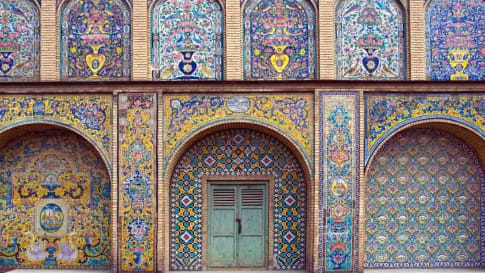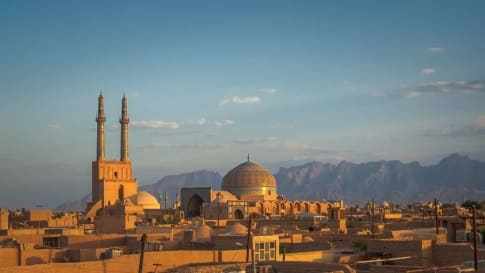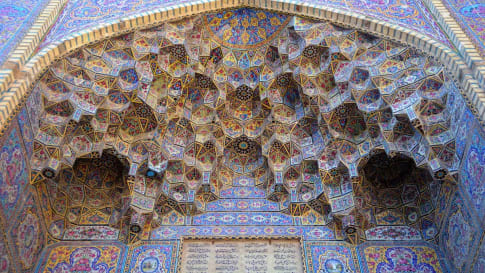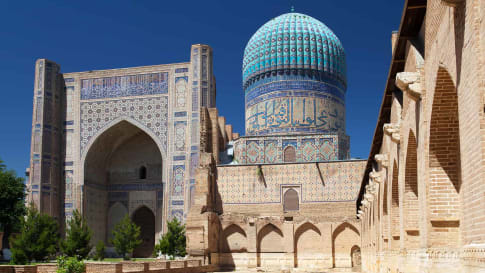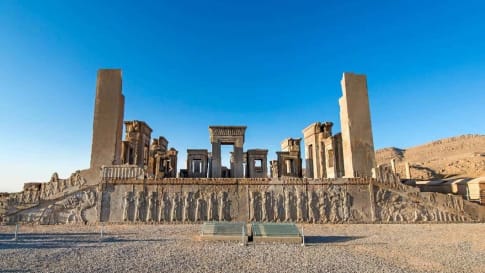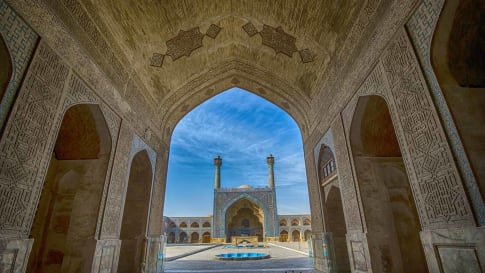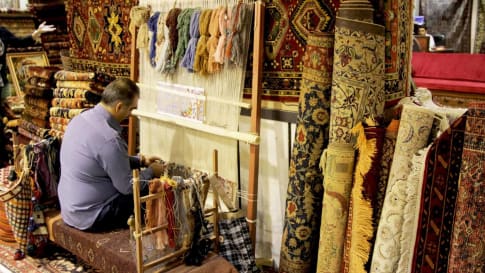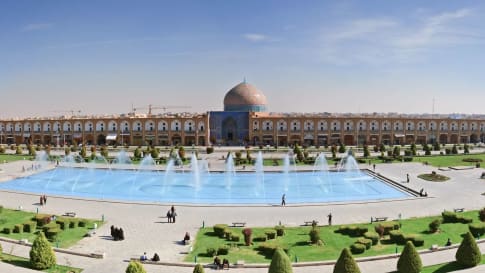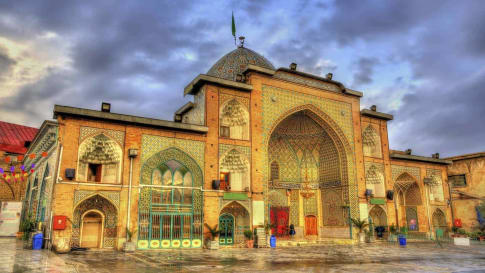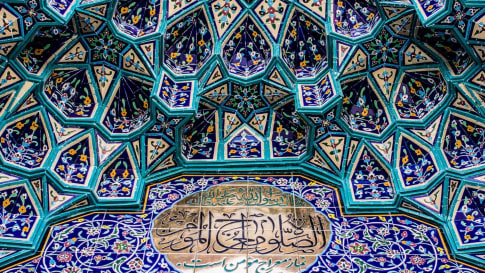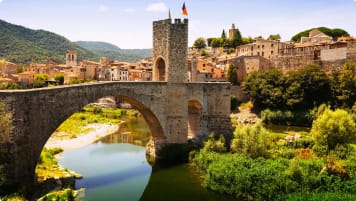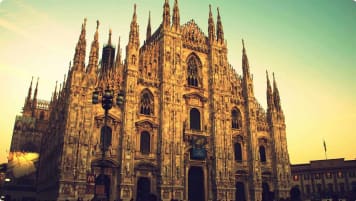Iran Culture and History Escorted Small Group Tour for seniors
Unlike its neighbours to the west and northwest, Iran had not adopted Christianity and it was the explosive spread of Islam and its ready adoption, without the Arabic language or customs, which helped unite the culture and greatly enrich Persian heritage. This small group tour program includes the great cities of Iran, historic sites, mosques, gardens, bazaars and teahouses for couples and solo travellers.
From $8,205USD

Highlights
- 1. Discover Iran's splendid ancient and modern mosques, minarets, mausoleums, and markets
- 2. Fall in love with Esfahan, home to Naqsh-e Jahan Square, surrounded by covered bazaars and home to the architectural jewels of the Safavid Empire
- 3. Visit Yazd, an historic Silk Road oasis town, home to the oldest Zoroastrian fire temple and the haunting Towers of Silence
- 4. Be inspired by Shiraz, known as the city of poets, literature, wine, and flowers, visiting two famous Persian Gardens, the Bagh-e Eram and the Narenjestan-e Ghavam

Departure Dates
| Departure Date | Price |
|---|---|
| 06 September 2025 Ends 23 September 2025 • 18 days $8,205 Twin $10,042 Single Available | Selected |
| 06 November 2025 Ends 22 November 2025 • 17 days $8,205 Twin $10,042 Single Available | |
| 06 April 2026 Ends 22 April 2026 • 17 days $8,205 Twin $10,042 Single Available | |
| 05 September 2026 Ends 21 September 2026 • 17 days $8,205 Twin $10,042 Single Available | |
| 05 November 2026 Ends 21 November 2026 • 17 days $8,205 Twin $10,042 Single Available | |
| 05 April 2027 Ends 20 April 2027 • days $8,426 Twin $10,409 Single Available | |
| 04 September 2027 Ends 20 September 2027 • days $8,426 Twin $10,409 Single Available | |
| 04 November 2027 Ends 20 November 2027 • days $8,426 Twin $10,409 Single Available |
Iran Culture and History escorted small group tour for seniors.
Odyssey offers easy, convenient, and relaxed escorted small group tours across Iran and beyond in the Middle East. We explore Iran's natural beauty, its ancient and Imperial heritage, its World Heritage Sites, and world famous cities, all with some truly spectacular scenery along the way. This and more is all waiting to be explored on one of Odyssey’s small group tours of Iran, designed for the senior traveller, and led by experienced, and enthusiastic like minded people.
Discover the fascinating history and culture this country has to offer on our Iran small group tour for seniors. This escorted educational tour is perfect for mature and senior travellers with an active mind, seeking to learn about one of the world's oldest civilisations, a fascinating country with many an ancient city to explore as you learn about central Iran. We regard this as one of the best travel tours in Iran for the senior traveller.
Travel on escorted Iran tour with us on a seventeen-day trip. Odyssey's Iran tour is a tour package that introduces the traveller to a guided tour of Iranian culture, focusing on the west of Iran, taking in ten key destinations and must see places . This Iran small group tour for seniors introduces several key UNESCO World heritage site of ancient Persia to the traveller with a knowledgable tour guide available at each location for Odyssey's Travellers to gain an appreciation of the history of Iran and Iranian culture.
Iran is located in southwestern Asia or the middle east, once home to one of the world’s oldest civilisations. Iran in ancient Persia was the centre of a great empire for many centuries. At its height, Ancient Persia's imperial territory stretched from the modern-day Balkan Peninsula in Europe, to the Indus River Valley in northwest India, and south to Egypt .
A country with a dramatic and colourful centuries-old history is bound to have incredible places to visit, ranging from the beautiful landscapes of the desert to persian architecure of merit . Iran is definitely no exception. Odyssey's Iran tour package has been refined over a number of years to provide the traveller with an insightful itinerary for an Iran tour. Odyssey offers muliple Iran tours each year for senior traveller interested in a small group Iran tour.
Iran Travel Tour Highlights
Our Iran tour begins and ends in Tehran, the modern capital of this ancient land. The itinerary for this Iran tour has the group tour leave Tehran with a tour guide to travel to nine destinations in central Iran and Western Iran. including two nights in Hamadan, three in Esfahan , two in Yazd and two in Shiraz. Along the way, we take in many of Iran’s UNESCO world heritage site (s). The lavish Golestan Palace , home of the Qajars and originally built in the Safavid era, exhibits the accumulated power of the Persian empire, the wealth and extravagance of the Persian monarchy. The palace of the persian empire is noted for its incorporation of Persian and Western design. Another monument that is considered a masterpiece of Persian architecture and a treasure of Islamic architecture is the 16 th century Shah Mosque (also known as Imam Mosque or the Royal Mosque ) located on the Naghsh-i Jahan Square (“Image of the World”, also known as Imam Square) in Isfahan . The Imam Square and the grand mosque are products of the massive urban planning undertaken in 1598, when Shah Abbas I moved the capital of Persia from Qazvin to Isfahan in an effort to avoid assaults by the Ottomans and to control the Persian Gulf.
Within this Iran tour package is also included the UNESCO world heritage site Pasargadae, where Cyrus the Great, founder of the Achaemenid dynasty, is entombed. A highlight of any Iran tour is the visit to the UNESCO World heritagelisted Persepolis , founded by Darius I in 518 BCE. Persepolis , the capital built by the Achaemenid kings, is located about 60 kilometres northeast of Shiraz. It was built on an immense half-artificial, half-natural terrace. The importance and quality of the monumental ruins make it a unique archaeological site where your tour guide is often effusive about the history and place of Persepolis in the history of ancient Persia.
On this Iran small group tour for seniors we also enjoy a guided tour of Takht-e Soleiman, the Soltaniyeh Dome, Bisotun, the Fire Temple and the Towers of Silence.
The Persian Garden
In addition, we visit several examples of that great addition to world horticulture - the Persian Garden . Water plays a central role in the persian garden of Iran, and it is reflected in the chahar bagh (“fourfold garden”), a model of garden philosophy and design used as a blueprint for landscaping throughout the Arab world and former Moorish territories in Asia and Europe.
The chahar bagh has its roots in the 6 th Century palace gardens of the Achaemenid Empire. The gardens of Cyrus the Great in Pasargadae share the same layout: they have a source of water in the centre (such as a fountain) that flows into four narrow canals, running at right angles and dividing the garden into four beds. The gardens are also marked with a walled enclosure, providing shade and a respite from the hot weather.
Iran City Tour, Ancient Civilisation, Rural Life
Led by our local guide and accompanied by an Odyssey program leader, our tour takes in the great cities of Iran : Tehran , Esfahan, and Shiraz . In Tehran , the program includes a trip to the National Museum, to see its archaeological treasures including glassware, ceramics, sculptures and mosaics from the persian empire. In the city of Esfahan we walk with the tour guide wacross Esfahan's beautiful bridges, and explore the Armenian quarter, as well as the major sights surrounding the main square.
However, we don't just study the major cities. Travellers also have the opportunity to study the country’s ancient Persian civilisations, as well as its Islamic present. Our small group Iranian tour affords travellers the opportunity to experience rural life as wellas a enjoying a diet of Persian food as part of the Iran package offered to on this group tour. We visit the ancient village of Masuleh, set on a steep slope of the Alborz Mountains, and Abyaneh, whose inhabitants still speak a dialect sprinkled with words from Middle Persian. There are also visits to historic sites, mosques , gardens, bazaars, and tea houses. Together, we will experience life in a country that has an incredible history and is undergoing significant changes.
Departures for Iran Tours
Odyssey's affordable and educational Iran tour package has been running for over 10 years. Should you choose to travelon this Iran package you draw from our years of experience as an independent tour operator offering a cultural tour to explore and learn about Iranian culture and ancient Persia. Odyssey Traveller has a minimum of two departures of the Iran Culture and History Escorted small group tours each year. We offer the Iran tour package to a maximum of 15 people each time. Additionally, Odyssey program leaders are aware of Iranian culture and trained to assist you with local etiquette and customs to ensure that you enjoy your vacation experience whilst on one of our Iranian tours for mature and senior travelers . This information will form part of your pre-travel departure pack. Our itinerary, is a combination of day tour(s) and overnight trips, is suitable for mature travellers, either couples or singles.
Here is the testimony of one Odyssey traveller from our 2019 tour:
Of our many travels, our trip to Iran was among the most memorable. The people, the country, the scenery were all wonderful, we felt very safe at all times. The people welcomed us to their country and wanted to engage in discussion every day. They were very friendly. Our guide and driver were excellent, so much history to absorb. Well worth the experience. - Kate and Kevin J. April 2019
If you want to learn more about Iran, read our country profile. We also prepared educative articles for our senior travellers for example on the Safavids in Persia, the history of Persian carpets, and you can browse all of our articles on Iran.
For more details about this tour, click the ‘Top 5’ or ‘Itinerary’ buttons above! If you’re keen to experience this tour, please call or send an email. Or, to book, simply fill in the form on the right hand side of this page.
Gallery
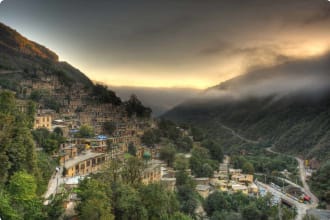
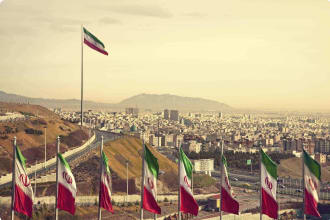
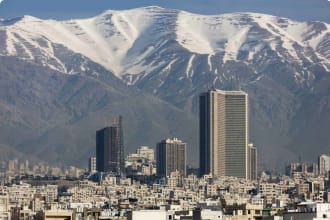
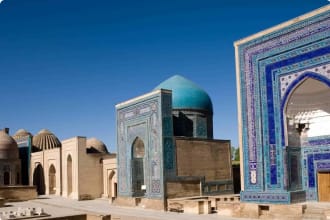

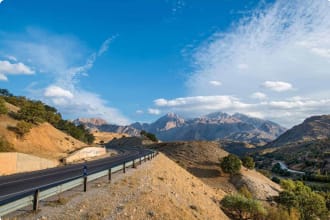
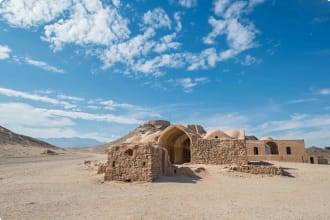
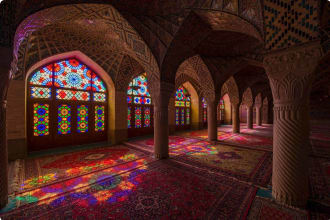
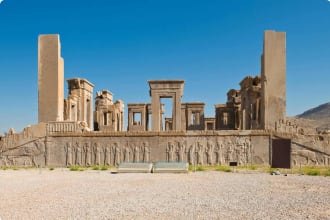
Itinerary
18 days
Day 1: Tehran
Accommodation: 2 nights at the Grand II 4 Star Hotel or similar accommodation.
Odyssey Travellers small group escorted tour to Iran commences in Tehran. Your tour leader provides a short introduction to Iran and Iranian culture followed by a welcome dinner of Persian food this evening.
Transfers to the hotel are included for those travelling on Odyssey’s designated flight following arrival at Tehran’s international airport (see details below). For those arriving on a different flight, transfers are not included. If time permits, we will have a short visit to the Sa’ad Abad Museum complex, otherwise it will be included on the following day or at the end of the tour.
EK 0971
Day 2: Tehran
Accommodation: Overnight at the Grand II 4 Star Hotel or similar accommodation.
Today we explore the sights of Tehran including the National Museum, the Carpet Museum to learn about the history of the Persian carpet, and the Carpet & Glassware Museum.
Day 3: Anzali
Accommodation: 1 night at the Sefid Kenar Hotel, or similar accommodation.
Today this small group Iran tour travels North with your tour guide via Rasht to Bandar-e Anzali (Anzali Port), on the southern shore of the Caspian Sea. Owing to its position and climate, the surrounding districts are characterised by green fields and forests. En route we visit the village of Masuleh, built into the steep slope of the Alborz Mountain. Here, the roof of one house is the yard of the house above and also the pavement in the village!
Day 4: Zanjan
Accommodation: 1 night at the Zanjan Bozorg Hotel or similar accommodation.
The group starts the day with a short walk along Anzali’s waterfront, then drive to the province of Zanjan. Zanjan is located northwest of Iran, and its geographical conditions, abundant water sources, and fertile soil have made the province suitable for farming and animal husbandry. Most villages of the province are of ancient origin. Here we visit the UNESCO world heritage listed Soltaniyeh Dome, which lies on a plain between two mountains. The capital in Persiaduring the time of the Ilkhanid Mongols from 1302, the mausoleum of Soltaniyeh has the world’s third largest brick dome. It was described by historian Michael Axworthy (2007) as “one of the grandest monuments of Iranian persian architecture.”
Day 5: Takab
Accommodation: 1 night at the Ranji Hotel or similar accommodation.
As part of this Iran package our itinerary today takes this group tour to the great Sassanian religious site of Takht-e Soleiman (the ‘Throne of Solomon”) en route to Takab. The UNESCO world heritage listed religious site of Takht-e Soleiman dates back to 800 BCE. The water filled crater and fire temple located here were of great symbolic significance to the Zoroastrian and are associated with the volcanic history of the area. We spend the night in Takab, a hilly market town.
Day 6: Hamadan
Accommodation: 2 nights at the Baba Taher Hotel, or similar accommodation.
Day 6 of this Iran tour for seniors travels to Hamadan via the Alisadr Cave, the largest cave in the world containing water. We explore the caves by paddle boat, and have lunch at the site. We then continue to Hamadan, known to classicists as Ecbatana, and the capital of Persia under the Achaemenids. It is situated in the desert on the Royal Road built by Darius the Great between the Mesopotamia and the Iranian Plateau in central Iran.
Day 7: Hamadan
Accommodation: Overnight at the Baba Taher Hotel, Hamadan, or similar accommodation.
Your tour guide leads this Iran tour today southwest to Kermanshah. En route we visit the Temple of Anahita in Kangavar, and the Sassanian bas-reliefs at Taq-e Bostan. After lunch we visit the UNESCO world heritage site of Bisotun to see its bas-reliefs and cuneiform inscriptions of the Persian empire.
Day 8: Kashan
Accommodation: 1 night at the Negin Traditional House, or similar accommodation.
Today the drive is through some of beautiful landscapes in the southeast that leads to Kashan, the first of the large oasis towns along the Qom-Kerman road which runs along the edge of the Dasht-e Kevir desert. Here we enjoy the restful shade of cupola-covered houses and the coolness of a pleasant persian garden with water fountains. We visit the acclaimed Persian garden called the Fin Garden, designed for Shah Abbas I, as well as Khan-e Tabatabi and Khan-e Borujerdi, merchant houses built in the late 1800s. The greenery and lively atmosphere of this well-tended oasis stands out against the the parched immensities of the surrounding desert.The merchant houses are a popular Iran destination for travellers. Tonight we stay at a beautiful Kashani traditional house.
Day 9: Esfahan
Accommodation: 2 nights at the Piroozy Hotel, or similar accommodation.
This group tour continues to travel south, visiting Abyaneh village on the way to Esfahan. A common saying during the Safavid (1502-1722) period was that “Esfahan was half the world.” Today the city is still Iran’s most beautiful city. The wonderful buildings may be attributed to Shah Abbas who made the town his capital in 1598. These have added to the considerable wealth of history already preserved in buildings from earlier periods. On arrival we enjoy a guided tour of the Vank Cathedral and the old Armenian quarter of the city.
In the evening we enjoy a guided tour of the Khaju Bridge, built under Shah Abbas II. The bridge doubles as a dam, and has always been as much a meeting place as a bearer of traffic. The bridge features two levels of terraced arcades, the lower containing locks to regulate the water flow. One can still see original paintings, tiles, and the remains of stone seats built for Shah Abbas II to sit on and admire the views. A pavilion was built in the centre exclusively for his pleasure. We also visit Sio She Pol (33 arches) Bridge before checking in to our hotel.
Day 10: Esfahan
Accommodation: Overnight at the Piroozy Hotel, or similar accommodation.
The itinerary provides for a full days group tour of Esfahan with our tour guide. The group tour begins with visits to Naqsh-e Jahan Square, and home to the Ali Qapu, Imam and Sheikh Lotfollah mosque(s) as well as the Gheisarieh Bazaar. After lunch, we will visit Chehel Sotoun (Forty Pillars reception hall and pleasure pavilion) and have some free time before dinner to explore the bazaar, exploring an opportunity to learn about the history of the Persian carpet.
Day 11: Yazd
Accommodation: Two nights at the Safaiieeh 4 Star Hotel, or similar accommodation.
Today we continue travelling south to Yazd, one of the Iranian strongholds of Zoroastrian, famous for its fire temples. En route we stop at Meybod to visit the Narein Castle.
The ancient Iranians venerated holy fires, and in Yazd, one such sanctuary has survived through the ages, although the building itself is pretty recent. However the fire has been been burning in Yazd for at least seven centuries.
If time permits, we’ll visit to the Towers of Silence on the outskirts of Yazd, before checking into our hotel (if not, we will visit them the following day). The towers were used by the Zoroastrian to dispose of the dead to avoid contaminating the soil with a body. Until this custom was forbidden in 1970, the Zoroastrian expose their dead to the birds in “towers of silence” (dakhmeh). There are two towers near Yazd, built in the nineteenth century according to a design from India, where many Zoroastrian live. At the terrace at the top, the dead were exposed, and devoured by birds. In this way, neither the earth nor the sacred fire were soiled.
Day 12: Yazd
Accommodation: Overnight at the Safaiieeh 4 Star Hotel, or similar accommodation.
Out in the desert and off the beaten path of the travellers is a fascinating Iran destination and worthy of a visit on any trip. Yazd with its adobe buildings, the windy narrow street plans, wind towers, and the qanat water supply system are a wonderful reflection of Persian architecture and ingenuity as a response to the local hot desert environment.
The old city of Yazd is where with your tour guide this small group tour of Iran for seniors has a full itinerary planned. Yazd was a branch leading to India of the Silk road, and was visited by the Venetian Marco Polo. Its ancient city centre and Persian Architecture facilitated UNESCO World heritage status. The lanes of the bazaar twist and turn and eventually lead to the Friday Mosque, regarded as one of the finest in Iran. The tall façade, the shallow dome and the interior of the sanctuary hall all sparkle with glazed tile. Most of the tilework dates to the fourteenth and fifteenth centuries, when the art was at its height and the city rich; no cost was spared in assembling thousands of precisely cut pieces of colored tile into large mosaics of geometric or floral design. In return for a small tip, the custodian unlocks the steps to the roof, and may even allow one to climb a minaret. In the old days, a muezzin would scale this five times a day to call his community to prayer; his modern successor understandably prefers to issue the summons from below, with the aid of records and a loudspeaker. Its a long trudge up a tight spiral staircase to the narrow balcony, apparently you hug the wall while admiring the view. The city sprawls below, dun-colored like the desert and is simply fascinating!
We also visit the Bagh-e Dolat Garden and Yazd’s Ateshkadeh (Zoroastrian Fire Temple) where the fire has burned continously for seven centuries.
Day 13: Shiraz
Accommodation: 3 nights at the Chamran New 5 Star Hotel, or similar accommodation.
Today we continue on through the beautiful landscapes of the desert to Shiraz. The itinerary has our tour guide stop en route to visit the ancient Abarqu Cypress tree, and the UNESCO world heritage site of Pasargadae, where Cyrus the Great, founder of the Achaemenid dynasty is entombed.
We arrive in Shiraz, city of poets, late in the afternoon. Shiraz has a rich and turbulent history and is considered to be an important part of the history of ancient Persia. It was spared destruction by Genghis Khan’s forces as well as the forces of Timur who followed 160 years later. Several earthquakes and Afghan raids destroyed the area, however it was resurrected as the Iranian capital in the mid 18th century during the Zand dynasty.
Day 14: Shiraz
Accommodation: Overnight at the Chamran New 5 Start Hotel, or similar accommodation.
Today this Iran tour arrives at an Iran destination considered to be a highlight for any group tour and for the tour guideleading a tour of Persia. Out in the beautiful landscapes of the desert, our tour package itinerary has the group spend time on a private tour with a guide of Persepolis. This is one of key highlights of the Persian empire and of Persian architecturefor many travellers. A UNESCO world heritage site, Persepolis was founded by Darius I in 518 BCE. Persepolis, the capital of the Achaemenid Empire, is located about 60 kilometres northeast of Shiraz. It was built on an immense half-artificial, half-natural terrace. The importance and quality of the monumental ruins which where preserved under the desert sand for centuries make Persepolis a unique archaeological site in Iranian culture and ancient Persia.
Late in the afternoon, our tour guide escorts the group around the Royal Necropolis (Naghsh-e-Rostam), before driving back to Shiraz. In Shiraz in the cooler part of the day the itinerary has a guided tour of the Persian Garden reffered to as the Eram Garden (Paradise Garden), followed by Nasir-o-Molk (Pink Mosque) and the Narenjestan-e Ghavam (Narenjestan Palace). We also visit the Zand citadel, the Arg-e Karim Khan, as well as the tombs of Hafez, a 14th century poet, and Sa’di, a 13th century poet.
Day 15: Shiraz
Accommodation: Overnight at the Chamran New 5 Start Hotel, or similar accommodation.
On day 15, this small group Iran tour takes a scenic drive west of Shiraz to take a guided tour of the ancient city of Bishapur (Shapur’s City), the capital under the Sassanian king Shapur I. Shapur’s armies defeated the Romans three times. Shapur had this city built by Roman soldiers who had been captured after the defeat of the Roman emperor Valerian in 260. It was here that the Roman General Valerian spent his final days in captivity.
What is fascinating is that many aspects of Bishapur’s architecture look Roman and do not belong to Iranian building traditions or refelect typical Persian architecture of the period. This city is full of strong Hellenistic-Roman and Persian influences in the architecture of its temple, audience hall, and defence structures. And the layout of the city is what specialists call the “Hippodamian Plan“, which means that the city looks like a gridiron, while the cities of ancient Persiawere usually were circular in design. The core of the city was the old castle, situated on a steep rock, which is in itself one of the most interesting geological features of the southern Zagros.
Day 16: Tehran
Accommodation: 1 night at the Grand II 4 Star Hotel, or similar accommodation.
This morning we will complete our trip to Shiraz. Your Iran tour will take the short flight to Tehran in the afternoon.
Day 17: Tehran
This morning we visit the National Jewel Museum. Our tour will end with a transfer to the airport for those booked on the evening flight (as advised by Odyssey). For those departing on a different flight, transfers are not included.
EK0980
Tour Notes
- Group size limited to 15.
- Itineraries may change if flight schedules, site availability, and other inclusions have to be amended prior to departure.
Includes / Excludes
What’s included in our Iranian Tour
- 16 nights of hotel accommodation.
- 16 breakfasts, 16 lunches, and 16 dinners.
- 1 internal flight in economy class and taxes.
- Transport in comfortable and modern coaches.
- All lectures, excursions, entrance fees, and local guides.
- Gratuities and necessary tips.
- Services of tour leader for the duration of tour.
- Visa Reference Number and supporting documents, required to apply for the Visa.
What’s not included in our Iranian Tour
- International airfares and departure taxes.
- Comprehensive travel insurance.
- Airport transfers if not on selected flights (as advised).
- Items of a personal nature such as telephone calls and laundry.
- Visa fee.
- Visa service (Odyssey offer Visa Service at additional cost).
Participants must be able to carry their own luggage, climb and descend stairs, be in good health, mobile and able to participate in 3-5 hours of physical activity per day, the equivalent of walking / hiking up to 8 kilometers per day on uneven ground.
Book now
Make it a private tour
Easing your journey
Crossing international borders with restrictions
The list of requirements to travel internationally has changed and will continue to change for several years. Odyssey is here to assist you in managing your way through these requirements:
For more information see our Crossing international borders with restrictions page.
Book With Confidence
If less than 30 days before your tour starts you are unable to travel as a result of Government travel restrictions, Odyssey Traveller will assist you with a date change, provide you with a credit or process a refund for your booking less any non-recoverable costs.
See Terms and conditions for details.
Peace of Mind Travel
The safety of our travellers, tour leader, local guide and support staff has always been our top priority and with the new guidelines for public health and safety for keeping safe for destinations around the world, we’ve developed our plan to give you peace of mind when travelling with us.
See Peace of Mind Travel for details.
Reviews
Odyssey has organised a most interesting and educational trip to Iran which is an amazing country and worth seeing. They took care with accomodation, made sure we saw all the great sights of which the country has many, looked after our welfare, had a wonderful guide making it a memorable experience. Eileen K. Oct '19
My goal in travelling to Iran was to increase my knowledge and understanding of its history and culture to do so in such congenial circumstances was a great privilege. Dianne P. Oct '19
Iran proved to be the friendliest and safest country I have ever travelled in. There are so many wonderful and interesting sights to see and the people are so interested in visitors they make such an effort to help all the time. Jill E. Oct '19
Of our many travels, our trip to Iran was among the most memorable. The people, the country, the scenery were all wonderful, we felt very safe at all times. The people welcomed us to their country and wanted to engage in discussion every day. They were very friendly. Our guide and driver were excellent, so much history to absorb. Well worth the experience. Kate and Kevin J. April 2019
Our Iran trip was a delight, from the rich history of ancient Persian civilisation to the beauty of Islamic architecture especially at Esfahan. We were pleased to have the opportunity to meet many Iranian people and our interactions were friendly and good fun. John M. April 2019
Iran was such a lovely interesting place, full of surprises. The program was perfect and the people so friendly. I learnt so much. Shirley G. Oct '18
The local guide was outstanding. She had excellent knowledge, helped us shop and went beyond reasonable to give us an authentic experience of Iran.
Participant -17
Reading List Download PDF
Iran: Empire of the Mind: A History from Zoroaster to the Present Day
Michael Axworthy
Iran often appears in the media as a hostile and difficult country. But beneath the headlines there is a fascinating story of a nation of great intellectual variety and depth, and enormous cultural importance. A nation whose impact has been tremendous, not only on its neighbours in the Middle East but on the world as a whole – and through ideas and creativity rather than by the sword.
From the time of the prophet Zoroaster, to the powerful ancient Persian Empires, to the revolution of 1979, the hostage crisis and current president Mahmud Ahmadinejad – a controversial figure within as well as outside the country – Michael Axworthy traces a vivid, integrated account of Iran’s past. He explains clearly and carefully both the complex succession of dynasties that ruled ancient Iran and the surprising ethnic diversity of the modern country, held together by a common culture.
With Iran again the focus of the world’s attention, and questions about the country’s disposition and intentions pressing, Iran: Empire of the Mind is an essential guide to understanding a complicated land.
The Complete Infidel's Guide to Iran (Complete Infidel's Guides)
Robert Spencer
The author of The Complete Infidel's Guide to ISIS and The Complete Infidel's Guide to the Koran returns with the sharp wit and boundless courage needed to expose the oncoming storm from Iran.
Revolutionary Iran: A History of the Islamic Republic
Michael Axworthy
A major new and definitive work by the author of Iran: Empire of the Mind
Ayatollah Khomeini's return to Tehran in February 1979 was a key moment in post-War international politics. A large, well-populated and wealthy state suddenly committed itself to a quite new path: a revolution based on the supremacy of Islam and contempt for both superpowers.
For over 30 years the Islamic Republic has resisted widespread condemnation, sanctions, and sustained attacks by Iraq in an eight-year war. Many policy-makers today share a weary wish that Iran would somehow just disappear as a problem. But with Iran's continuing commitment to a nuclear programme and its reputation as a trouble-maker in Afghanistan, Lebanon and elsewhere, this is unlikely any time soon. The slow demise of the 2009 'Green Revolution' shows that Revolutionary Iran's institutions are still formidable.
About the author:
Michael Axworthy's Iran: Empire of the Mind established him as one of the world's principal experts on this extraordinary country and in his new book, Revolutionary Iran, he has written the definitive history of this subject, one which takes full account of Iran's unique history and makes sense of events often misunderstood by outsiders.
Reviews:
'Balances scholarly precision with narrative flair ... Axworthy does the best job so far of describing the Iran-Iraq war ... He revisits, and convincingly reinterprets, defining moments of the Islamic republic ... [with] scholarly rigour and first-class analysis. Anyone interested in this most complex of revolutions would do well to read [this book]' Economist
'An impressive exploration of Iran's development since 1979 into an unpredictable pseudo-democracy ... [a] calm and literate portrait of the Islamic Republic' Guardian
'If you were to read only one book on present-day Iran you could not do better than this ... Axworthy revokes the sound and fury of the revolution itself' Ervand Abrahamian, Times Higher Education
'Packed with gobbets of information and policy advice on how to deal with Iran' Telegraph
City of Lies: Love, Sex, Death and the Search for Truth in Tehran
Ramita Navai
Lying in Tehran is about survival.
Welcome to Tehran, a city where survival depends on a network of subterfuge. Here is a place where mullahs visit prostitutes, drug kingpins run crystal meth kitchens, surgeons restore girls' virginity and homemade porn is sold in the sprawling bazaars; a place where ordinary people are forced to lead extraordinary lives.
Based on extensive interviews, CITY OF LIES chronicles the lives of eight men and women drawn from across the spectrum of Iranian society and reveals what it is to live, love and survive in one of the world's most repressive regimes.
Iran Awakening: A memoir of revolution and hope
Shirin Ebadi
In this remarkable book, Shirin Ebadi, Iranian human rights lawyer and activist, and Nobel Peace Prize laureate, tells her extraordinary life story.
Dr Ebadi is a tireless voice for reform in her native Iran, where she argues for a new interpretation of Sharia law in harmony with vital human rights such as democracy, equality before the law, religious freedom and freedom of speech. She is known for defending dissident figures, and for the establishment of a number of non-profit grassroots organisations dedicated to human rights. In 2003 she became the first Muslim woman, and the first Iranian, to be awarded the Nobel Peace Prize.
She chronicles her childhood and upbringing before the Iranian Revolution, her education and student years at the University of Tehran, her marriage and its challenges, her religious faith, and her life as a mother and as an advocate for the oppressed. As a human rights campaigner, in particular for women, children and political prisoners in Iran, her autobiography is a must-read for anyone fascinated by the life story and beliefs of a courageous and unusual woman, as well as those interested in current events (especially those of the Middle East), and those who want to know the truth about the position of women in a Muslim society.
The Shah
Abbas Milani
Though his monarchy was toppled in 1979 and he died in 1980, the life of Mohammad-Reza Shah Pahlevi, the last Shah of Iran, continues to resonate today. Here, internationally respected author Abbas Milani gives us the definitive biography, more than ten years in the making, of the monarch who shaped Iran's modern age and with it the contemporary politics of the Middle East.
The Shah's was a life filled with contradiction—as a social reformer he built schools, increased equality for women, and greatly reduced the power of the Shia clergy. He made Iran a global power, courting Western leaders from Churchill to Carter, and nationalized his country's many natural resources. But he was deeply conflicted and insecure in his powerful role. Intolerant of political dissent, he was eventually overthrown by the very people whose loyalty he so desperately sought. This comprehensive and gripping account shows us how Iran went from politically moderate monarchy to totalitarian Islamic republic. Milani reveals the complex and sweeping road that would bring the U.S. and Iran to where they are today.
Tangled inTurquoise
Bobbi Davari
"Tangled in Turquoise" (the 'colour' of Iran) is a wonderfully moving account of the author's life which began in Britain just after the Second World War. Born into a very ordinary family, she tells of the changes in life-style she experienced when, as a young woman, she fell in love with an Iranian, whom she married, and then lived with in Iran during the 1970s. The Shah was ruling Iran at the time and did so for the next eight years until the dramatic turn of events that culminated in the Iranian Revolution in 1979, bringing with it a change in culture under a new political regime. These events, together with the war between Iraq and Iran which ensued not long after, altered the course of her life again when she and her husband decided to leave Iran and return to Britain in the 1980s. But that's only part of the story...
As you travel with her through the pages of her life from the West to the Middle East - and back again - her gripping story will hold your attention right to the end. Prepare to be affected by what has been described as a 'story and a half': it's a page-turning must-read for all those interested in people.
This is Bobbi Davari's first book.
The Persians: Ancient, Mediaeval and Modern Iran
Homa Katouzian
In recent years, Iran has gained attention mostly for negative reasons—its authoritarian religious government, disputed nuclear program, and controversial role in the Middle East—but there is much more to the story of this ancient land than can be gleaned from the news. This authoritative and comprehensive history of Iran, written by Homa Katouzian, an acclaimed expert, covers the entire history of the area from the ancient Persian Empire to today’s Iranian state.
Writing from an Iranian rather than a European perspective, Katouzian integrates the significant cultural and literary history of Iran with its political and social history. Some of the greatest poets of human history wrote in Persian—among them Rumi, Omar Khayyam, and Saadi—and Katouzian discusses and occasionally quotes their work. In his thoughtful analysis of Iranian society, Katouzian argues that the absolute and arbitrary power traditionally enjoyed by Persian/Iranian rulers has resulted in an unstable society where fear and short-term thinking dominate. A magisterial history, this book also serves as an excellent background to the role of Iran in the contemporary world.
The Silk Road - Central Asia, Afghanistan and Iran: A Travel Companion
Jonathan Tucker
Stretching from the ancient Chinese capital of Xian across the expanses of Central Asia to Rome, the Silk Road was, for 2,000 years, a vibrant network of arteries that carried the lifeblood of nations across the world. Along a multitude of routes everything was exchanged: exotic goods, art, knowledge, religion, philosophy, disease and war. From the East came silk, tea, jade, paper, porcelain, spices and Buddhism; from the West, horses, weapons, lions, precious stones and cotton. From its earliest beginnings in the days of Alexander the Great and the Han Dynasty, the Silk Road expanded and evolved, reaching its peak under the Tang and Byzantine empires and gradually crumbling along with the decline of the Mongol empire. In this beautifully-illustrated book, which covers the Central Asian section of the Silk Road - from Lake Issy Kul through Tashkent, Samarkand, Bukhara, the Kyzyl Kum Desert, Khiva and Merv to Herat, Kabul and Iran - Jonathan Tucker uses traveller’s anecdotes and a wealth of literary and historical sources to celebrate the cultural heritage of the countries that lie along the Silk Road and illuminate the lives of those who once travelled through the very heart of the world.
The Silk Road in World History
Xinru Liu
The Silk Road was the contemporary name for a complex of ancient trade routes linking East Asia with Central Asia, South Asia, and the Mediterranean world. This network of exchange emerged along the borders between agricultural China and the steppe nomads during the Han Dynasty (206 B.C.E.-220 C.E.), in consequence of the inter-dependence and the conflicts of these two distinctive societies. In their quest for horses, fragrances, spices, gems, glassware, and other exotics from the lands to their west, the Han Empire extended its dominion over the oases around the Takla Makan Desert and sent silk all the way to the Mediterranean, either through the land routes leading to the caravan city of Palmyra in Syria desert, or by way of northwest India, the Arabian Sea and the Red Sea, landing at Alexandria. The Silk Road survived the turmoil of the demise of the Han and Roman Empires, reached its golden age during the early middle age, when the Byzantine Empire and the Tang Empire became centres of silk culture and established the models for high culture of the Eurasian world. The coming of Islam extended silk culture to an even larger area and paved the way for an expanded market for textiles and other commodities. By the 11th century, however, the Silk Road was in decline because of intense competition from the sea routes of the Indian Ocean. Using supply and demand as the framework for analysing the formation and development of the Silk Road, the book examines the dynamics of the interactions of the nomadic pastoralists with sedentary agriculturalists, and the spread of new ideas, religions, and values into the world of commerce, thus illustrating the cultural forces underlying material transactions. This effort at tracing the interconnections of the diverse participants in the transcontinental Silk Road exchange will demonstrate that the world had been linked through economic and ideological forces long before the modern era.


